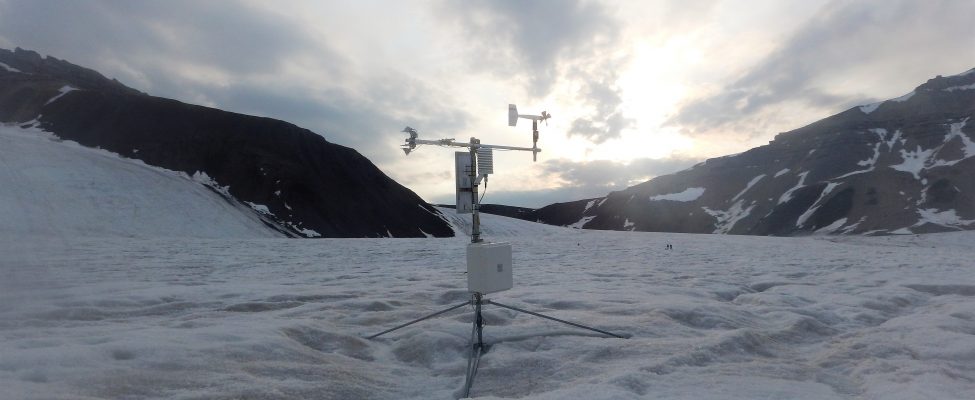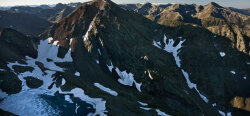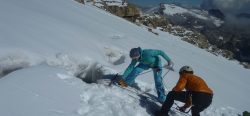NAME AND OWNER
Adam Mickiewicz University Polar Station “Petuniabukta”, Svalbard (AMUPS) is owned by Adam Mickiewicz University in Poznan, Poland.
LOCATION
The station is located on the western coast of Petunia Bay (Norwegian: Petuniabukta), north-easternmost part of Isfjorden, central Spitsbergen west coast largest fiord, built at the foot of Pyramiden mountain, 2 m a.s.l., 50 m from the shoreline.
Central part of Spitsbergen island (Svalbard) enraptures its unique character of the inner fiord landscape, with a variety of morphogenetic environments and biotaIn simple terms, this word is a collective term for all living things. To refer only to animals, we use the word fauna, and for plants, flora. See also 'biodiversity'.... More, from the coastline to surrounding mountains, reaching 1000 m of altitude, diversified ice masses in extensive valleys and flowing down from ice plateaux to the sea. Svalbard is accessible for scientific research based on the Svalbard Treaty (since 1920). Svalbard Environmental Protection Act determined the erection of national parks, although, the nearest area of the station is open for visitors without special permits. Research projects need to be registered. More info www.sysselmannen.no.
In the vicinity of the station remnants of former activities of Russian coal mine Pyramiden, abandoned in 1998, are visible. Nowadays it is operating mostly for tourists. Larger settlement, the capital of Svalbard Longyearbyen, is 60 km far. During the summer season, each day tourist ships are cruising from Longyearbyen to Pyramiden harbour (4 km from the station).
BIODIVERSITY AND NATURAL ENVIRONMENT
The surrounding environment is determined by high latitude conditions (>78oN), but at the distance from Spitsbergen western coast oceanic influences are distinctly weaken. High ArcticDefinitions of the Arctic vary according to environmental, geographical, political, cultural and scientific perspectives. Some scientists define the Arctic as areas having a high latitude, long winters, short, cool summers,... More climateThe average weather we would expect over a long period of time (seasons, years, decades). Climate varies from place-to-place across the Earth. Climate is determined by long-term (over at least... More is then quasi-continental, perceptibly warmer and dryer in summer. It is also an area the less glacierized in Svalbard. Except glacial and past-glacial features, vast areas are exhibiting periglacial influences in the zone of continuous permafrostPermafrost is frozen ground that remains at or below zero degrees Celsius (32 degrees Fahrenheit) for two or more years. It forms in regions where the mean annual temperature is... More, thawing to the depth of 1.5-2.0 m. High ArcticDefinitions of the Arctic vary according to environmental, geographical, political, cultural and scientific perspectives. Some scientists define the Arctic as areas having a high latitude, long winters, short, cool summers,... More tundraA type of ecosystem in which tree growth is limited by low temperatures. The origin of the word is from from the Kildin Sami word t?ndâr, meaning "uplands" or "treeless mountain tract". In the northern... More characteristic plants are dwarf shrubs and mosses. In the vicinity of the station it is possible to meet reindeers, arcticDefinitions of the Arctic vary according to environmental, geographical, political, cultural and scientific perspectives. Some scientists define the Arctic as areas having a high latitude, long winters, short, cool summers,... More foxes, various birds, but also more frequently polar bears. For that purpose safety training and carrying the gun is mandatory.
HISTORY AND FACILITIES
Adam Mickiewicz University staff were investigating the area since 1984, using until 2009 the old hut “Skottehytta”. In 2011, a temporary station was built nearby. It was moved on the western coast of the bay and expanded to the current size in 2015. The station consists of two 10 m2 bedroom barracks and one kitchen/livingroom/laboratory facility (18 m2). In between them, during the summer, a tent hall (40 m2) is raised. Electricity is from fossil fuel generator (230 V) and solar panels (12 V). Supplies to the station (equipment, food and fuel) are brought from Poland at the beginning of summer or bought in Longyearbyen.
GENERAL RESEARCH AND DATABASES
Investigations conducted at the station are covering the monitoring of the natural environment in its abiotic and biotic parts. Meteorological surveys are based on stationary observations at the station, as well as automatic weather stations registration around the bay. Sites of permafrostPermafrost is frozen ground that remains at or below zero degrees Celsius (32 degrees Fahrenheit) for two or more years. It forms in regions where the mean annual temperature is... More studies, comprising ground temperature measurements are established. During the summer glaciological, hydrological, geomorphological, geological, geochemical, botanical observations are performed. Data are acquired according to standards of the Polish Governmental Integrated Monitoring system.
HUMAN DIMENSION
Svalbard capital Longyearbyen is a common place of arrival on the archipelago by regular flights from Norway or by ships. Longyearbyen with its over 2000 inhabitants has all facilities including airport, harbour, hospital, markets, hotels, gas station etc. Currency in operation is NOK, ATM is also available. From Longyearbyen to the station the transportation is organized on of everyday operating touristic ships (one way trip 4-5 hours) to Pyramiden. The crew during the summer in Pyramiden is about 20 people, there is a helipad, hotel and bar. Currency – NOK, cash only.
ACCESS
The most convenient way to access Longyearbyen is by airplane from Norway. Ship cruises to Pyramiden are in the morning and in the afternoon. Finally to get to the station from the pier in Pyramiden it takes up to one hour walking or the transportation is organized on zodiac, prior to earlier arrangement. In the case of the transportation of larger amount of cargo, shipping from Poland is possible about the end of June. Zodiac boats are used for transportation within the fiord. On land only walking is allowed.

























